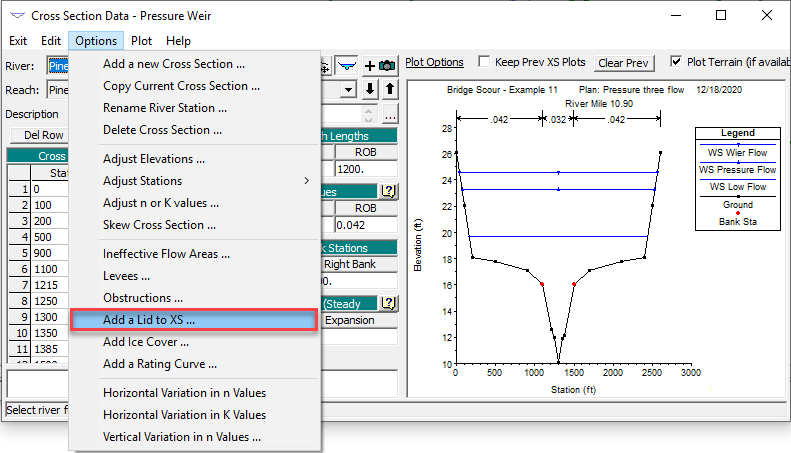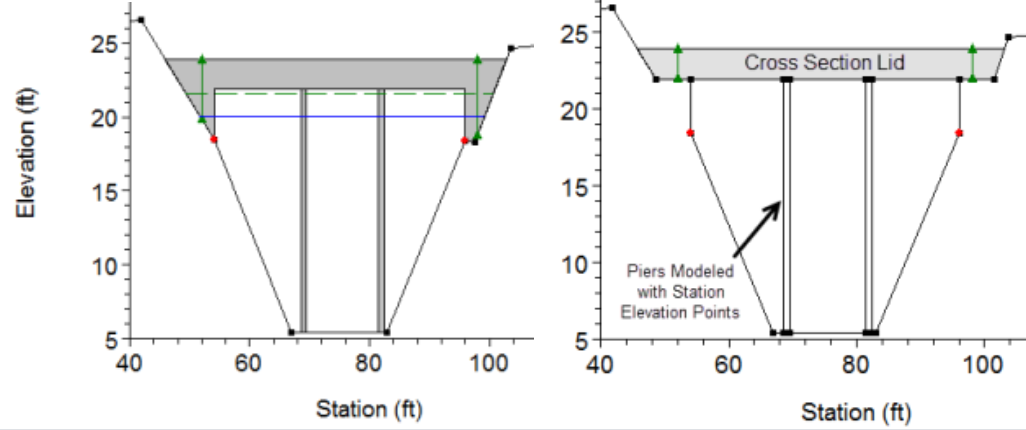The HEC-RAS bridge modeling approaches (particularly Pressure-Weir) can cause instabilities in HEC-RAS sediment models. Bridge cross sections tend to be much closer together than standard cross section spacing. Additionally, the upstream and downstream bridge face cross sections replicate themselves just inside the bridge, which usually generates four tightly spaced cross sections, much closer together than the cross section spacing throughout the rest of the model. This cross section spacing can cause model instabilities and erratic scour patters around structures. There are three main options for dealing with problematic bridges in HEC-RAS.
Option 1: Delete the Bridge:
If the bridge does not affect upstream hydraulics significantly, consider the impact of deleting it. It is common to remove high chord bridges from sediment models. If the bridge does induce upstream backwater effects that affect transport, there are two other common modeling approaches.
Option 2: Bound the Bridge with Pass Through Nodes:
Setting the upstream and downstream cross sections to Pass-Through Nodes will also make the bridge "pass through". Making the bridge a pass through element, converts the bridge into a fixed-bed feature. The model will use the standard HEC-RAS hydraulics to compute backwater effects and bridge influences on hydraulics, without scouring (or depositing) in the bridge itself. This approach leverages the bridge hydraulics capabilities that are useful in a reach-scale model (e.g. backwater effects, not contraction scour) without computing localized sediment effects at the structure, which the 1D, mobile bed model cannot resolve. The pass through bridge approach does make one major assumption. It does not allow reach-wide base level change. If the whole reach incises 1m, the pass through bridge will not, and will create a numerical check dam.
Option 3: Model the Bridge as a Lidded Cross Section:
If bridges cause instabilities in the sediment model but cannot be removed without affecting the hydraulics, consider modeling the bridge with a Lidded Cross Section (see discussion of Lidded Cross Sections in the main HEC-RAS manual). Define the bridge as a cross section, including piers as elevated station-elevation points (see figure below). Then, in the cross section editor, select *Options → Add Lid to XS…* to model the bridge deck as a lid.

Lidded cross sections do not provide full bridge hydraulics computations. HEC-RAS will not compute pressure flow or momentum loss at lidded cross section. But lidded cross sections (with piers represented in station elevation data) will account for bridge area and wetted perimeter, solving the energy equation.

Warning: Do Not Use the Sediment Model to Simulate Bridge Scour
The 1D, mobile-bed, sediment transport features in HEC-RAS are reach-scale capabilities. It is not appropriate to use this model to calculate bridge scour, especially pier or abutment scour. Bridge scour is a fundamentally multi-dimensional process that is outside the scope of many of the assumptions of the 1D transport model. The empirical, Department of Transportation, HEC-18 bridge scour capabilities are available in the Hydraulic Design editor of HEC-RAS. Use that Bridge Scour tool for local scour analyses (or a 3D, CFD, or physical model).
